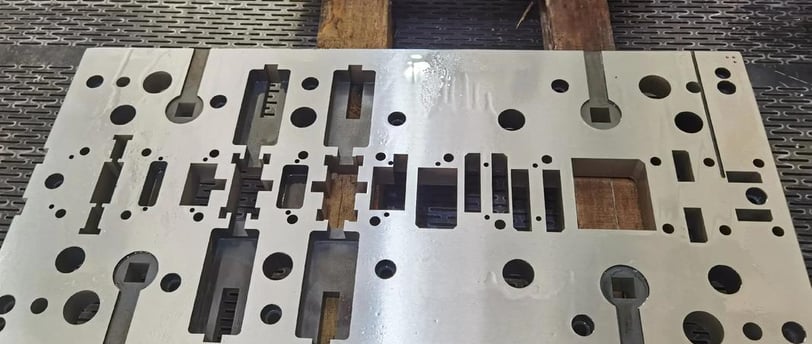Analysis of the Importance of Stamping Die in the Electronics Industry
1/29/2025


Introduction to Stamping Dies
Stamping dies are essential tools in the manufacturing sector, particularly within the electronics industry. These precision instruments are designed to cut, shape, and manipulate metal sheets or components into usable parts that are integral to a wide range of electronic devices. The process begins with a die set, which typically consists of two halves— the upper and lower die. Once the metal sheet is placed between these two components, a stamping press applies significant force to perform various operations, such as bending, piercing, or blanking.
The role of stamping dies extends beyond mere shaping; they also ensure uniformity and quality in production. In the electronics industry, where components must meet specific electrical and mechanical standards, the accuracy achieved through stamping dies is paramount. For instance, connectors, housings, and circuit boards all require parts manufactured with a high degree of precision to function properly. The use of stamping dies facilitates this by producing components that fit together seamlessly, reducing the likelihood of errors during assembly.
Additionally, stamping dies play a critical role in improving manufacturing efficiency. By utilizing advanced die design and automation technology, manufacturers can streamline the production process. This not only accelerates the output of electronic parts but also minimizes material wastage, thus contributing to cost savings and enhanced sustainability. Moreover, the consistent quality of products manufactured with stamping dies promotes brand reliability and consumer trust in electronic devices.
In conclusion, stamping dies are vital to the electronics industry, serving as key tools that enhance precision, efficiency, and quality in the manufacturing process. Their ability to generate high-quality components supports the overall functionality and reliability of electronic products.
Applications of Stamping Dies in Electronics Manufacturing
Stamping dies play a critical role in the electronics manufacturing sector by enabling the precise production of a wide array of components essential for various applications. Particularly, these specialized tools are instrumental in the fabrication of circuit boards, connectors, and enclosures, which are fundamental to the functionality and integrity of electronic devices.
One of the most prevalent applications of stamping dies is in the creation of printed circuit boards (PCBs). Stamping dies facilitate the efficient production of intricate patterns and circuits that allow for the effective interconnection of electronic components. By using stamping processes, manufacturers can achieve high-volume production while ensuring consistency and accuracy in the production of these vital components. For instance, companies like PCBWay have adopted stamping dies to enhance their manufacturing capabilities, resulting in increased output and reduced lead times.
Another significant application is found in the manufacture of connectors, where stamping dies are used to produce the metal terminals that serve as the points of connection in electrical circuits. These connectors must meet strict quality and performance standards, and stamping dies help ensure that the dimensions and tolerances of each component are consistently maintained. An example can be observed in companies such as TE Connectivity, which effectively employs stamping dies to meet the needs of their extensive product range, ensuring that all connectors adhere to the highest standards of quality and reliability.
Furthermore, stamping dies are also utilized in the production of enclosures for electronic devices. These enclosures not only protect internal components but also contribute to the aesthetic appeal of electronic products. Manufacturers like Apple leverage the precision of stamping dies in creating seamless, visually appealing enclosures that meet functional and design requirements simultaneously.
Through these applications, stamping dies contribute significantly to the efficiency and productivity of electronic component manufacturing. By streamlining production processes and ensuring high-quality outcomes, they remain indispensable tools within the electronics industry.
Benefits of Utilizing Stamping Dies in Production
The use of stamping dies in the electronics manufacturing process offers a myriad of benefits that significantly enhance production efficiency and product quality. One of the primary advantages is the increased production speed. Stamping dies can create multiple components simultaneously, which accelerates the manufacturing cycle and allows for higher output rates. This is particularly advantageous in an industry where timely delivery is crucial to maintain competitive advantage.
Moreover, stamping dies contribute to improved accuracy in the production of electronic parts. The precise engineering of these dies ensures that each stamped component meets the specifications required for high-performance electronics. This precision minimizes the risk of defects and rework, which can lead to costly delays and lower product reliability. As the electronics industry continually shifts towards miniaturization, having consistent and accurate components becomes imperative for integrating smaller parts into various devices.
Cost-effectiveness also plays a significant role in the advantages presented by stamping dies. The initial investment in stamping technology may be substantial; however, the long-term savings from reduced labor costs and material waste are noteworthy. Stamping dies facilitate the efficient use of raw materials, leading to less scrap, which aligns with contemporary sustainability goals within the manufacturing sector.
Furthermore, the global demand for high-quality electronic products necessitates the adoption of processes that ensure superior output. By utilizing stamping dies, manufacturers can better meet these quality standards, ultimately leading to enhanced customer satisfaction. The integration of advanced stamping techniques supports industry trends, allowing operators to pivot quickly to produce innovative designs without compromising on quality or performance.
Future Trends in Stamping Die Technology for Electronics
The electronics industry is on the cusp of significant transformation, particularly concerning stamping die technology. One prominent trend is the advancement in materials used for stamping dies. Innovative materials, including high-strength steels and composite materials, are being developed to enhance durability and reduce wear and tear. These materials can withstand the demanding conditions of high-speed stamping, thereby increasing the longevity of the die and reducing operational costs associated with frequent replacements.
Another critical trend is the automation of die manufacturing processes. As production demands grow, manufacturers are increasingly adopting automated technologies to streamline the production of stamping dies. Automation not only enhances the precision of die manufacturing but also accelerates the production timeline. This shift allows companies to respond more rapidly to market changes and consumer needs. Furthermore, automated systems can optimize material usage, significantly minimizing waste and lowering manufacturing costs.
Integration with digital technologies, particularly within the framework of Industry 4.0, will also shape the future landscape of stamping die technology. Smart manufacturing technologies, such as the Internet of Things (IoT) and real-time data analytics, are anticipated to revolutionize how stamping dies are designed, monitored, and maintained. By embedding sensors within stamping dies, manufacturers can collect and analyze data regarding wear patterns and operational efficiency. This data-driven approach enables predictive maintenance, reducing the likelihood of unexpected failures and extending the service life of the dies.
In conclusion, the future trends in stamping die technology for the electronics industry indicate a shift towards enhanced materials, increased automation, and the integration of digital technologies. These advancements are expected to lead to greater efficiency, improved production capabilities, and a more adaptive manufacturing environment, ultimately meeting the evolving requirements of the electronics sector.
